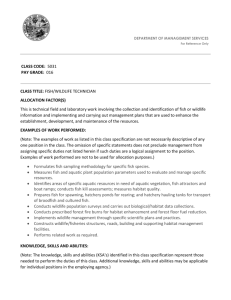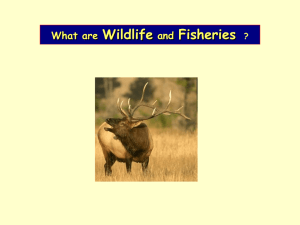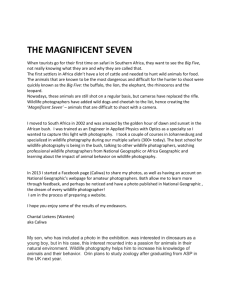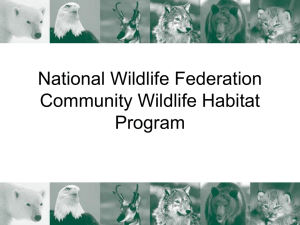Wildlife & Fisheries
advertisement
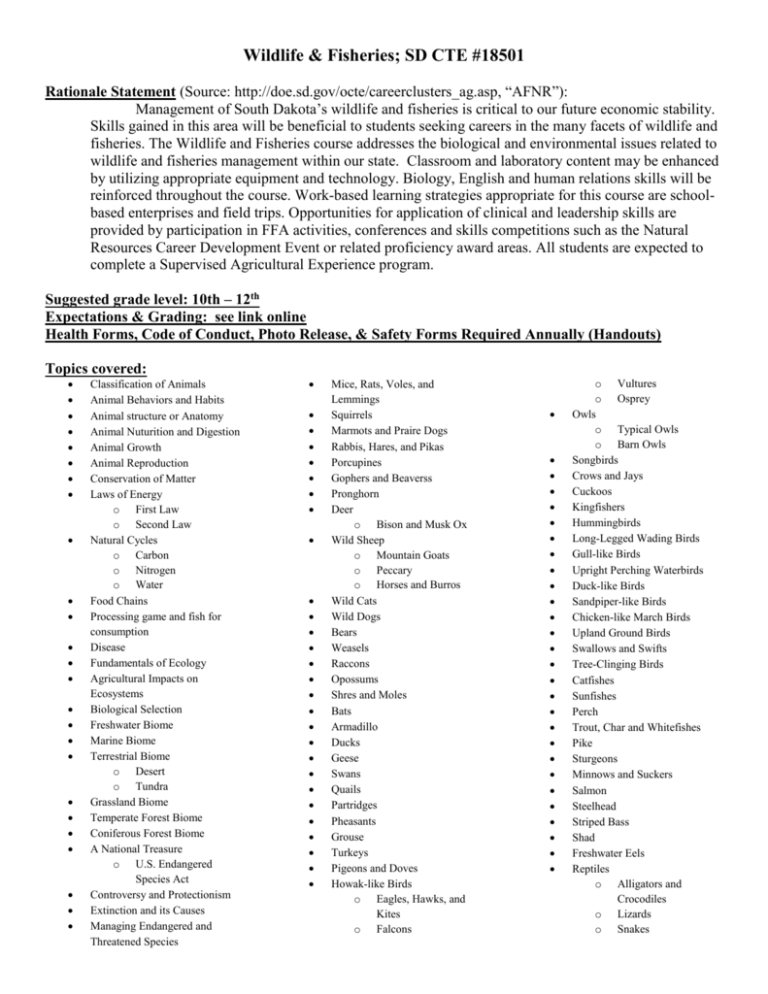
Wildlife & Fisheries; SD CTE #18501 Rationale Statement (Source: http://doe.sd.gov/octe/careerclusters_ag.asp, “AFNR”): Management of South Dakota’s wildlife and fisheries is critical to our future economic stability. Skills gained in this area will be beneficial to students seeking careers in the many facets of wildlife and fisheries. The Wildlife and Fisheries course addresses the biological and environmental issues related to wildlife and fisheries management within our state. Classroom and laboratory content may be enhanced by utilizing appropriate equipment and technology. Biology, English and human relations skills will be reinforced throughout the course. Work-based learning strategies appropriate for this course are schoolbased enterprises and field trips. Opportunities for application of clinical and leadership skills are provided by participation in FFA activities, conferences and skills competitions such as the Natural Resources Career Development Event or related proficiency award areas. All students are expected to complete a Supervised Agricultural Experience program. Suggested grade level: 10th – 12th Expectations & Grading: see link online Health Forms, Code of Conduct, Photo Release, & Safety Forms Required Annually (Handouts) Topics covered: Classification of Animals Animal Behaviors and Habits Animal structure or Anatomy Animal Nuturition and Digestion Animal Growth Animal Reproduction Conservation of Matter Laws of Energy o First Law o Second Law Natural Cycles o Carbon o Nitrogen o Water Food Chains Processing game and fish for consumption Disease Fundamentals of Ecology Agricultural Impacts on Ecosystems Biological Selection Freshwater Biome Marine Biome Terrestrial Biome o Desert o Tundra Grassland Biome Temperate Forest Biome Coniferous Forest Biome A National Treasure o U.S. Endangered Species Act Controversy and Protectionism Extinction and its Causes Managing Endangered and Threatened Species Mice, Rats, Voles, and Lemmings Squirrels Marmots and Praire Dogs Rabbis, Hares, and Pikas Porcupines Gophers and Beaverss Pronghorn Deer o Bison and Musk Ox Wild Sheep o Mountain Goats o Peccary o Horses and Burros Wild Cats Wild Dogs Bears Weasels Raccons Opossums Shres and Moles Bats Armadillo Ducks Geese Swans Quails Partridges Pheasants Grouse Turkeys Pigeons and Doves Howak-like Birds o Eagles, Hawks, and Kites o Falcons o Vultures o Osprey Owls o Typical Owls o Barn Owls Songbirds Crows and Jays Cuckoos Kingfishers Hummingbirds Long-Legged Wading Birds Gull-like Birds Upright Perching Waterbirds Duck-like Birds Sandpiper-like Birds Chicken-like March Birds Upland Ground Birds Swallows and Swifts Tree-Clinging Birds Catfishes Sunfishes Perch Trout, Char and Whitefishes Pike Sturgeons Minnows and Suckers Salmon Steelhead Striped Bass Shad Freshwater Eels Reptiles o Alligators and Crocodiles o Lizards o Snakes o Turtles and Tortoises Amphibians o Frogs and Toads o Salamanders and Newts Role of Private Institutions o Farmers and Ranchers o Industry o Private Citizens o Game Farms and Preserves Role of Special Interest Groups o Environmental Organizations o Recreation Interests Role of Government o Government Agencies o National Parks and Mountains o National and International Law Multiple Use Concept of Management Wildlife Careers o Education o Supervised Experience o Employer Expectations o Occupational Safety Conserving of the Soil Maintaining a Pure Water Supply Preserving Air Quality Preserving and Restoring Wildlife Populations and Habitats Reclaiming Damaged or Polluted Resources Foundation for Agriculture Sources of Materials for Medicines Mechanism for Natural Cycles Recreation o Intrinsic Value o Hunting and Fishing for Sport o Game Laws and Regulations o Using Campgrounds, Trails, Roads, and Waterways Basis for Commerce Safety Education The Principle of Stewardship Ethics, Privileges and Responsibilities Wildlife Management Outdoor Recreation Management Delivery Plan: Students will read assigned materials; participate in discussions, individual, and group activities; identify fish, insects and wildlife from SD Natural Resources CDE; follow current events/news from SD & MN state sources; construct a related project to enjoy outdoors or improve habitat; view movie selection(s) chosen by class that follow topics; utilize courses.k12.sd.us for support material, quizzes, and tests. SECTION I ZOOLOGY AND ECOLOGY BASICS o Chapter 1 Principles of Zoology—Week 1 o Chapter 2 Principles of Ecology—Week 1 o Chapter 3 Understanding Relationships Between Ecology and Agriculture—Week 2 o Chapter 4 Biomes of North America—Week 3 o Chapter 5 Our Wildlife Resources—Week 4 SECTION II ZOOLOGY AND ECOLOGY OF MAMMALS o Chapter 6 Gnawing Mammals—Week 5 o Chapter 7 Hoofed Mammals—Week 6 o Chapter 8 Predatory Mammals—Week 7 o Chapter 9 Marine Mammals—Skip o Chapter 10 Unusual Mammals—Week 7 SECTION III ZOOLOGY AND ECOLOGY OF BIRDS o Chapter 11 Waterfowl—Week 8 o Chapter 12 Game Birds—Week 9 o Chapter 13 Birds of Prey—Week 10 o Chapter 14 Songbirds and Other Perching Birds—Week 11 o Chapter 15 Other Birds of North America—Week 12 SECTION IV ZZOOLOGY AND ECOLOGY OF FISHES, REPTILES AND AMPHIBIANS o Chapter 16 Freshwater Fishes—Week 13 o Chapter 17 Anadramous and Diadromous Fishes—14 o Chapter 18 Saltwater Fishes and Fauna—Skip o Chapter 19 Reptiles and Amphibians—Week 15 SECTION V CONSERVATION AND MANAGEMENT o Chapter 20 Responsible Management of Wildlife Resources—Week 16 o Chapter 21 Conservation of Natural Resources—Week 17 o Chapter 22 The Human Connection to Wildlife and Natural Resources—Week 18 Resources: “Fish & Wildlife; Principles of Zoology and Ecology”, 2nd Ed, L. DeVere Burton “SD GFP Website” “MN DNER Website” “Wildlife & Fisheries”, courses.k12.sd.us (Blackboard Learn) SD CTE Core Technical Standards: (Bloom’s Taxonomy Level : Standard) Indicator #1: Demonstrate the importance of fish and wildlife management, including their respective habitats. o Applying WF 1.1 Apply knowledge of natural resource components to the management of wildlife and fish. Illustrate the interdependence of organisms within an ecosystem. Dramatize predator and prey population relationships. Create a food web to interpret wildlife relationships. Differentiate factors that influence population density and population dispersion. Operate a field study of an ecosystem and record observations of species interactions. o Understanding WF 1.2 Identify fish and wildlife species. Identify aquatic species based on morphological characteristics. Identify game animals based on morphological characteristics. Identify birds based on morphological characteristics. Classify endangered and threatened species of wildlife. Identify non-game animals based on morphological characteristics. Conduct a field inventory of a wildlife or aquatic species and document the findings. o Understanding WF 1.3 Identify healthy habitat for wildlife and fish. Recognize the characteristics of healthy wildlife habitat for various species. Select characteristics of a healthy aquatic habitat for various fish species. Report on methods for improving wildlife or fish habitat. Survey a habitat and report on comprehensive improvements that must be made. Examine waterfowl migration, including why migration occurs. Discuss land and water carrying capacity for fish and wildlife. Indicator #2: Identify economic and social issues related to fish and wildlife. o Understanding WF 2.1 Discuss the importance of hunting/harvesting fish and wildlife species and the related responsibility. Translate SD Game, Fish and Parks hunting/fishing laws. Paraphrase trapping methods and create a position paper on the topic. Describe fish harvesting techniques and procedures. Describe wildlife harvesting techniques and procedures. Identify different viewpoints of hunting/fishing by interviewing people. Identify management practices to protect fish and wildlife from overexploitation. o Applying WF 2.2 Demonstrate processing techniques to use game and fish as food sources. Identify potential diseases carried by game species that could infect meat. Illustrate food products that can be obtained from various wildlife species. Illustrate the uses of South Dakota fish for consumption. Safely process wild game and fish species for consumption. Demonstrate safe food handling techniques. Demonstrate safe and proper food preparation. o Applying WF 2.3 Dramatize safety practices related to wildlife and fish. Demonstrate safety practices when hunting or fishing. Become HuntSafe certified. Demonstrate appropriate responses to accidents and injuries that occur while hunting and fishing. Indicator #3: Compare life patterns of fish and wildlife. o Analyzing WF 3.1 Differentiate fish and wildlife function and form in their daily lives. Compare and contrast physiological differences between mammals, birds and fish by viewing skeletal and muscular diagrams. Distinguish form and function of body systems in various wildlife species. Examine survival techniques used by wildlife species. o Understanding WF 3.2 Identify seasonal rituals of fish and wildlife species. Examine phases of ungulate animal rut. Examine annual big game migration. Describe why some animals don’t migrate. Discuss the hibernation process and identify animals that hibernate. Analyze breeding seasons and rituals for wildlife and fish. o Evaluating WF 3.3 Diagnose wildlife and fish diseases. Evaluate the causes of diseases in fish and wildlife. Appraise photos of fish and wildlife diseases to identify the affliction. Select wildlife disease management techniques.



